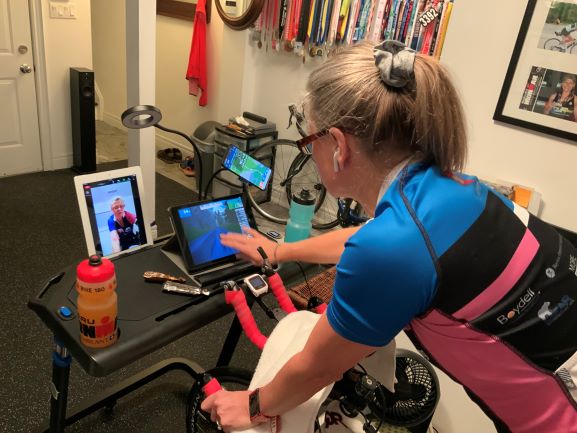A beginner’s guide to smart trainers, online platforms and pain cave set up: The Battle of the Bluetooth
Don't let technology get the better of you when it comes to your indoor training set up

The popularity of virtual cycling platforms during a cold Canadian winter in the midst of a pandemic lockdown has skyrocketed. Triathletes are being drawn into the world of Zwifting and Zooming (or Rouvy and Discord, Trainer Road and MindBody – take your pick of platforms) in record numbers. And why not? The idea of doing the workout your coach has designed in Training Peaks loaded directly into Zwift and simply pedalling along with your fellow athletes, letting the software take control of your power output while you smile at each other in a video call, is a nifty way of passing two hours in the basement on a snowy Saturday morning.
That is … once you have conquered the battle of the Bluetooth!
For athletes with a high degree of technical prowess and a number of the latest devices, it seems like an easy task to get it all set up and running in time for that 7:00 a.m. meet up. Except, when it isn’t – and that seems to affect athletes of a “certain age” more frequently.
The amount of technology required to join the fun can be shocking, especially for those of us who are cobbling together their set-up one piece at a time. Since starting down this road last year, I have added a power meter to my bike (finally, and long overdue!) and invested in a smart trainer (also long overdue) in order to become a Zwifter. My husband joined in, so we now have two bikes side-by-side in our pain cave looking to connect.
This is when the battle of the Bluetooth began. We had to sort out which Wahoo trainer to connect to, which power meter to select, and how to disconnect the wireless speaker that was supposed to be providing music and suddenly started blasting out the eternal Zwift start up jingle. Somewhere in the house there is a phone, or iPad, that is streaming music that had to be tracked down and controlled, too.
This is all before trying to figure out how the game actually works! Without reading glasses, it is impossible to see details on that small screen. That left us figuring out how to share it to the TV that does not have Bluetooth, which took investing in a hub compatible with the laptop or iPad so an HDMI cable … or three … could share to the screen. (Upgrading to Apple TV has not been determined necessary … yet.)
Next was to learn how to use Zwift Companion to understand group events – creating and accepting them – and how to join them in Zwift. Great! Now, let’s all join in a Zoom call so we can see each other and chat during our rides! This requires an entirely separate device to run both Zwift and Zoom at the same time. More Bluetooth connections required. By this time, I’ve had to invest in a high stand that can accommodate all of these devices where I can reach forward to control them, and a ring light to combat the bad lighting in the basement. My reading glasses are always within reach, along with my nutrition and hydration.
Now – let’s get my coach’s workout into Zwift so I can just ride along and let “Erg Mode” take over. Working through the steps of accepting the group ride, figuring out how to find the workout and when to start it (after the group ride starts) is complicated, but worth the effort.
The most recent addition has been a set of wireless earbuds so I can actually hear what people are saying on the call – which triggered another Bluetooth battle to get them connected to the right device at the right time.
Still lingering in the background, unresolved, is adding a Bluetooth heart rate monitor to the mix and figuring out how to use the Zwift Companion app while riding to send text messages without having to single finger type on my phone while struggling up a 10 per cent grade.
Logging in to be ready with all of this for a 7:00 a.m. group workout takes some effort and can be complicated even further by unstable internet connections and having to log out and back in to get the audio working properly.
When it all comes together and works – it’s great!! With practice, it will probably become easy.
And then – I’ll be so ready to just get on my bike outside and ride with just my Garmin, GPS – and real people to wave at.
My advice for anyone experiencing the frustration of working through this process? Keep at it, one Bluetooth battle at a time. And don’t let a bad technology day unravel your ride. If it isn’t working, just go old school by sitting on your bike and pedalling.
Sandie Orlando is an associate coach, age group triathlete, writer and marketing/communications manager for CL Performance Training. #CLPT #CLPerformanceTraining #CLPTStrong #Pro.Body.Coach.
